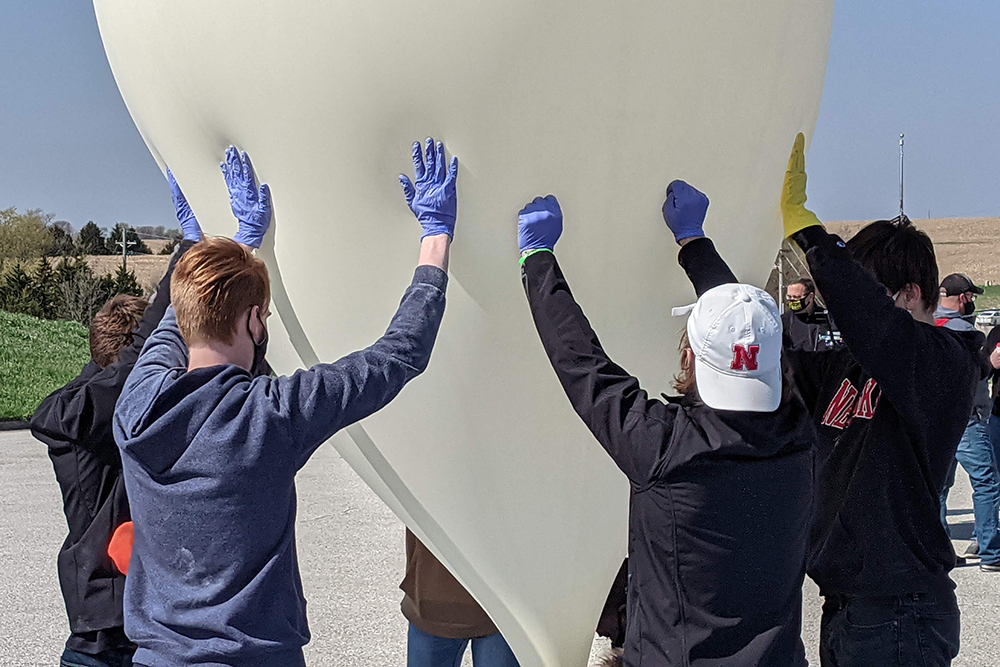Calendar Icon
Jun 11, 2022
Person Bust Icon
By Karl Vogel
![]() RSS
Submit a Story
RSS
Submit a Story

RELATED LINKS
One year before its solar panel payload must be ready to fly on a NASA mission, a team comprised of College of Engineering undergraduate students and Nebraska middle and high school students, will test the payload by sending it nearly 20 miles into the sky.
Nebraska's Big Red Satellite (BRS) Team will conduct a high-altitude balloon (HAB) launch - weather permitting - Saturday, June 18 from the grassy field north of the Nebraska Innovation Campus parking lot to the north of the intersection of Transformation Drive and North 19th Street.
Sending the payload nearly 100,000 feet toward outer space will allow the team to test the performance of perovskite solar panels before the are included next year on a NASA flight to the International Space Station (ISS).
"What we want to do on the HAB is get a simulation of how our payload is going to perform in space without actually putting it into space," said John Helzer, one of the BRS team leads and a junior in mechanical engineering.
Saturday's payload will be a Styrofoam container with GPS tracker and a radio transmitter that allows students on the ground to communicate with satellites. The focus of the payload, however, will be the solar panels and a sensor to track the angle of the sun, both mounted on the outside of the container.
After the balloon is launched, students will track the current-voltage characteristic curve (or I-V curve) from the data transmitted from the payload. This will provide a graphical representation of the solar panel's performance by measuring the voltage applied across the device and the current flowing through it.
Some team members will follow the GPS signals to retrieve the payload after the balloon bursts in the upper atmosphere and a parachute lowers the payload back to earth.
In early 2021, the Big Red Satellite team was chosen by NASA's CubeSat Launch Initiative, to be one of the 14 teams (colleges, universities, and nonprofit organizations) from nine states that will provide small auxiliary satellite payloads to be flown on a future mission.
The BRS satellite will be deployed into outer space by astronauts on the ISS, allowing the experiment to be conducted during orbit before orbital decay causes the device to burn up entering Earth's atmosphere.
BRS undergraduate students meet with and mentor the middle and high school teammates once a week – typically on Saturday mornings.
The design of the payload and communications systems isn't the only benefit for team members. Karen Stelling, professor of practice in mechanical and materials engineering and the team's faculty advisor, said it's a valuable real-world learning opportunity.
"Unlike the work they do in class or in a lab, this is not about working until you get a grade. This project will be managed to the end product, not to the grade," Stelling said. "There's definite growth and maturity that happens when you have a deadline to meet, and you have to solve project challenges.
"Plus, the team structure is not something you normally see in an undergraduate environment. Similar to professional design teams, they're taking on roles and mentoring younger (high and middle school) team members."
The Nebraska team is also benefitting from networking opportunities with other teams in the CubeSat program, including one from Rhodes College, a private liberal arts college in Tennessee that doesn't have an engineering program.
"The team from Rhodes is launching a similar perovskite payload to ours," Stelling said. "They've been working with the University of Oklahoma and they helped us connect with them as a source for the perovskite cells.
"They also helped connect us with The Aerospace Corporation, which is providing us some direction on how to create the AMU on our own."
With the Nebraska team officially "under contract" to provide the payload to NASA on May 4, 2023, Helzer said the importance of the launch has resonated with the team this semester.
"Everything's for real now, more than with our first HAB launch last year," said Helzer. "The biggest change is taking this idea from the theoretical to the actual hands-on and physical. It's the real deal now."
Also part of the launch events on Saturday will be representatives from other University of Nebraska Aerospace Club teams. Husker students, K-12 students and their parents are encouraged to attend and learn about these student team opportunities.
Submit a Story